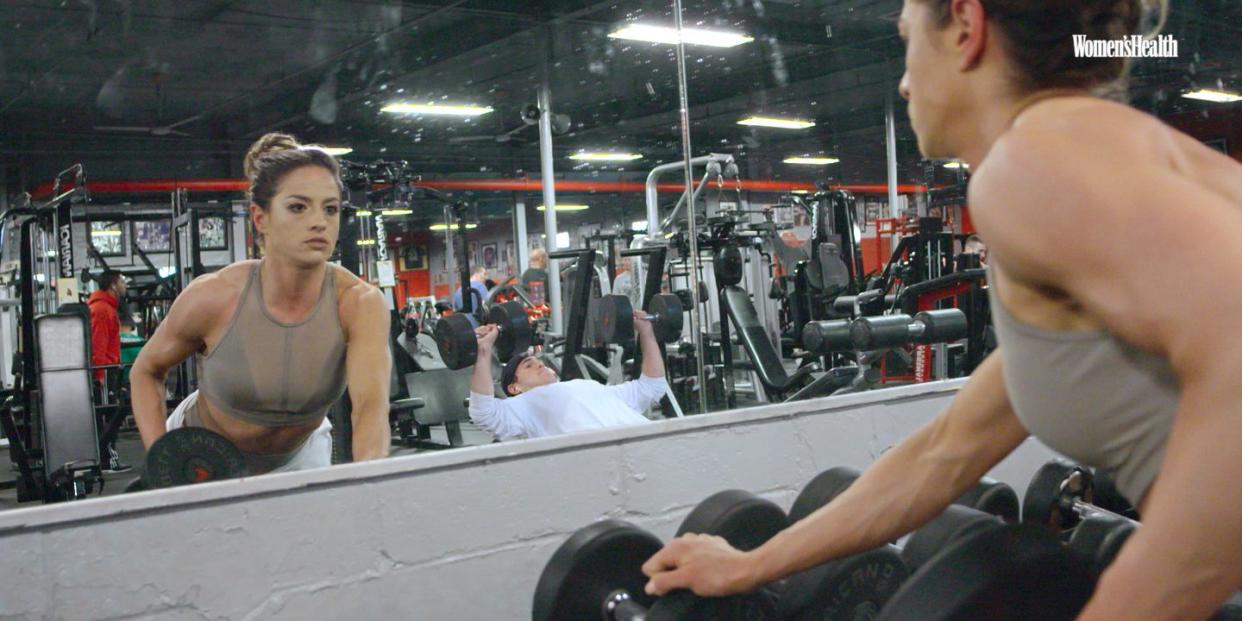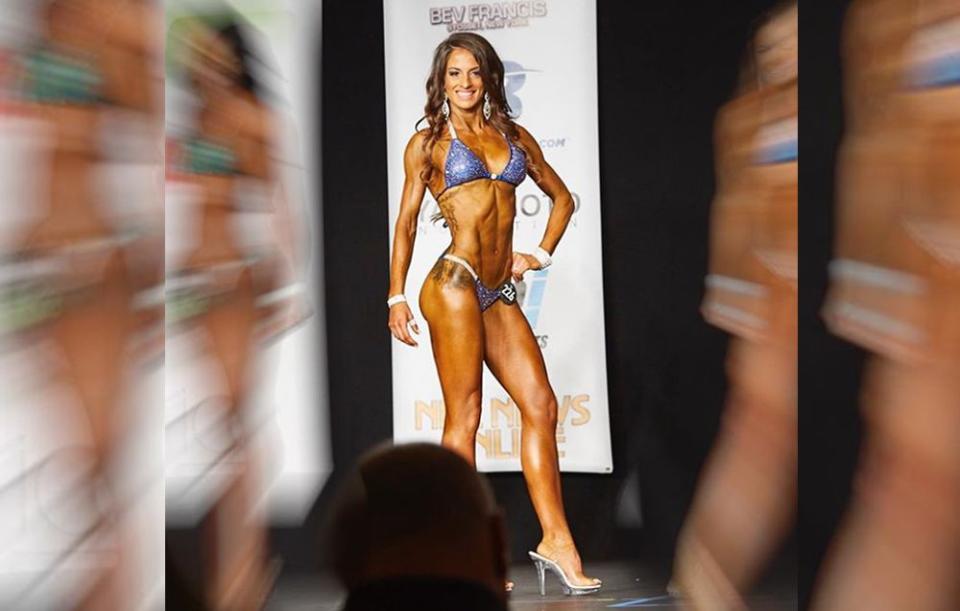Go Behind The Scenes Of A Bikini Competition To See What One's Really Like IRL

If you're a Real Housewives fan, you may have followed the fitness journeys of Tamra Judge and Teresa Giudice as they trained for bikini competitions. (Shout-out to those super impressive muscles, ladies!) But beyond the Bravo-lebrities' experience...the world of bikini competitions probably feels like a bit of a mystery. What's going on behind-the-scenes of those photos of ultra-tan, ultra-fit women in flashy two-pieces on Instagram?
Well, the spectacle is only part of what bikini competitions are actually about. Beyond the sky-high heels and smiles are months of intense preparation, which can be detrimental to physical and mental health, for some.
Whether you're thinking about signing up for one yourself or you're just curious, here's everything you need to know about bikini competition training-what the show is like, how people train, whether it's safe for you, and what real bikini competitors have to say about them.
The first thing to know is that bikini competitions don't come cheap.
Becoming a part of this world is quite an investment, as there are a number of costs associated with bikini competitions, beyond what you might expect, says Mindy Irish, NASM-certified personal trainer, contest prep and posing coach (plus, a national-level bikini competitor herself).
Here's how it adds up, according to Irish:
Competition coach: $100–$300 or more a month
Posing coach: $50-$100/hour or more
Heels: $50/pair
Spray tans: $125-$150
Hair and make-up artists: $100-$300 for the package
Swimsuit: $300-$1000 or more, depending on if it's custom made or heavily stoned.
So yeah, it's not exactly an inexpensive hobby. That said, "many of us use this as part of our own income, so competing has purpose well beyond the expenses."
So, what actually happens at a bikini competition?
"Competitive bodybuilding shows are held year-round, country-wide in a variety of venues and [of different] calibers," says Irish. Individual federations-like National Physique Committee (NPC), one of the larger ones-host distinct events, but the rules and guidelines are generally pretty uniform.
A post shared by MINDY IRISH: BS 💪🏼 NASM CPT (@fitgalmindy) on Sep 20, 2018 at 4:01pm PDT
"Within the show, there are different categories for women and men," says Irish. These categories include Bikini, Figure, Physique, Fitness, and Bodybuilding-all of which have unique expectations for muscle size and leanness from the contestants.
The "Bikini" division, specifically, is for competitors with the least muscle mass of all five categories, Irish explains. The requirements for this category include: "A foundation of muscle which gives shape to the female body, full round glutes with a slight separation between the hamstring and glute area, and a small amount of roundness in the delts" according to the NPC bikini division rules. (Think: Distinct muscle definition, but not huge, bulging muscles.) This category generally has the highest number of participants.
"Competitors within this category are organized in to different classes based on age and height. And, as a class, they walk out on stage and compete based on stage presence, body composition, and an overall balance of muscle proportions," she says. Each class may have 15 to 30 (or more) competitors.
As a class, competitors in the bikini division are judged on a front pose, a back pose, and a 10-second individual posing routine (as well as their transitions and flow)-all while wearing five-inch clear heels.
They're also evaluated based on their stage bikini style, full hair and makeup, and a dark competition spray tan.
A post shared by MINDY IRISH: BS 💪🏼 NASM CPT (@fitgalmindy) on Nov 1, 2018 at 4:54pm PDT
"Generally speaking, the goal [of this division] is for a competitor to present a lean, athletic physique with balanced muscular proportions," says Irish. "All while representing poise, beauty, and athleticism in a polished presentation on stage."
Given these guidelines, preparation for a bikini competition is pretty intense.
What happens on stage is really the last step. The first is having a solid fitness base-before signing up for a competition, Irish says you should have at least a year or two of weight training under your belt.
Once you've decided to do a competition, you can amp up strength training to focus on muscle groups that need more work developing. "This time is called the building, or improvement season, and this can last as long as six months to years at a time," says Irish. "The goal in this phase is to eat enough food to be able to add muscle, train routinely, sleep on a rhythm, and keep body fat levels in check."
Individuals don't typically make these plans for themselves, though. As the contest gets closer, most participants use a hired coach who will "read the competitor's body and guide their nutrition and training to prep for the contest," says Irish.
While plans vary based on the competitor, generally the most challenging part starts at 12 to 24 weeks before the show.
"This is the stage competitors cut calories and eat very strict diets," to help keep body fat low and highlight muscle definition, explains Amelia DiDomenico, ACE-certified personal trainer, owner of Amrose Fitness Studio in West Hollywood, California. "Everything is measured, even to the ounces of vegetables." And competitors generally split their diet evenly between fat, carbs, and protein, a.k.a. macros.
That said, competitors need to be careful not to cut calories too much, as this will start to deteriorate hard-earned muscle. (Note: Some competitors opt for very low-carb plans, but DiDomenico says that's not recommended. And generally carbs are cut in the final week or weeks leading up to the competition.)
This is also usually the stage where competitors ramp up cardio (often in a fasted state) and continue weight training-sometimes they'll do both types of workouts a day, says DiDomenico, with rest days built in.
Competitors also generally have to drink a gallon of water a day during this phase. This is partially to help stay hydrated during intense training. But also, according to DiDomenico, when competitors drink that much water, their body gets used to expelling that amount of water. So the strategy is, when they decrease intake closer to the competition, their body is still used to expelling the same amount of water, which helps emphasize more visible muscle definition.
A post shared by MINDY IRISH: BS 💪🏼 NASM CPT (@fitgalmindy) on Nov 1, 2018 at 5:39am PDT
Learning how to pose is also a big part of preparation. "The biggest factor in competitive bodybuilding, and specifically the bikini division, is the art of displaying a competitor's physique on stage-you have to be able to move with fluidity and avoid looking robotic in the process, all while in five-inch heels and a bikini," says Irish.
To make sure competitors feel confident on stage, daily posing practice usually starts about eight to 12 weeks before the competition, she says. "Many competitors use a posing coach, either in person or online," she adds.
Because of the hardcore prep work involved, Bikini competitions are definitely controversial.
The extreme nature of bikini competitions doesn't come without risks. Physically, burnout is a concern-when your body doesn't fully recover from the rigorous workouts. While signs of overtraining can be nebulous, some red flags are irritability, moodiness, exhaustion and sleep problems, plus workout plateaus. (Basically, you hit a point where you feel weak and you're not improving.)
Calorie depletion is another worry. "The light that shines in a person's eyes just sort of goes out at a certain level of calorie depletion-[I see] unstable emotions like hysterical crying, anger, depression, and more, irrational thoughts, hunger pangs, sleeplessness, listlessness or feeling 'sick,' irregularity with hormones and menstrual cycles, and bad breathe," says DiDomenico.
There are also mental health risks associated with training for bikini competitions. "From a clinical perspective, these competitions mask high levels of body dysmorphia, eating disorders, anxiety, depression, and obsessive-compulsive disorders," says DiDomenico (who also has a master's degree in clinical psychology).
Ashley Borden, ACE-certified personal trainer, has also witnessed this firsthand-a former friend would flip between binge eating and training. "She would go into competition mode, and everything changed," says Borden. "It was more militant than anything I had ever seen-she restricted everything and was a grumpy, selfish jerk."
Obviously, this isn’t to say that all bikini competitors have eating disorders, Borden and DiDomenico both stress-for some, it's quite the opposite.
"From my personal training perspective, working hard for a goal and accomplishing it can lead to increases in self-esteem and self-efficacy," says DiDomenico. For that reason, bikini competitions are certainly not a hard no in her book, but she does offer this caution: "I think that both emotional and mental stability are important for competitors to consider before signing up to compete."
(If you have a history of disordered eating or body dysmorphic disorder, these kinds of competitions are likely not a good idea-remember, organizations like NEDA can provide help and resources.)
The reality: Some people have positive experiences with bikini competitions...some don't.

For Alejandra Mace, training for a competition helped her deal with her divorce. While she ultimately decided not to compete as an act of self-care during a rough time, the process of training was the reward itself. "I realized even though it felt like I didn’t accomplish what I put my mind to, I had actually accomplished quite a lot," Mace . "I had learned how to be strong. I had learned how to respect myself and be proud of myself."

Ariella Grinberg echoed the same sentiment-after she traded cardio for weights and participated in her first bikini competition, she was hooked on the confidence she found. "I’ve competed in six shows in two years, made some of my best friends from competitions, and launched my own business," she says.
A post shared by Brittany Loeser (@brittanyannette) on Jul 23, 2018 at 6:57am PDT
However, other bikini competitors have different feelings about their experiences. Brittany Loeser passed out on a Stairmaster after depriving her body and training too much. "In the throes of prep, I was completely blind to how much all the eating restrictions and bingeing were taking a toll on my body. And when it came time for the bikini competition, I didn’t even enjoy it that much," she previously told WomensHealthMag.com. For her, focusing on mindful eating and how her body feels is more rewarding (and she still loves lifting, even though she's not training for a competition).
Ultimately, whether a bikini competition is right for you depends on who you are.
As popular as bikini competitions are, they're not for everyone. But for people looking for a new and challenging outlet for their passion for fitness, it can be a great goal to work toward, says Irish.
Of course, it's a big commitment. "Like all competitions or sports, competing at that level requires extreme training, discipline, and focus," says DiDomenico.
"That's what competitive bodybuilding is all about: The love of the process and the enjoyment of getting on stage and showcasing our years of dedication and hard work," adds Irish.
If that sounds up your alley, awesome! Training and competing is an impressive feat that pushes your body and your mind-just be mindful of your physical and mental health along the way. And if not, you can still admire the hard work that goes into bikini contests while sticking to a fitness and nutrition plan that works for you (no competition necessary).
('You Might Also Like',)

